|
|
|
|
Four Seasons of Koi Breeders |
|
|
|
|
|
"Koishi" (koi-breeder) are people who make living by producing
Nishikigoi
On this page, we show you the four seasons of koi productions and the
works of our "Koishi" at Nishikigoi Niigata Direct. |
|
|
|
We aim for healthy, big and beautiful Nishikigoi. |
|
|
|
|
 |
 |
We, at Nishikigoi Niigata Ditrect, aim to deliver healthy and attractive
Nshikigoi to you.
We do not mix our KHV negative ,virus-free fish with other koi from outer
sources.
The three koi farms that constitute Nishikigoi Niigata Direct observe "The
National Guidelines for Nishikigoi Export" by Ministry of Agriculture,
Forestry and Fisheries. And take periodical examinations on KHV and SVC-
twice a year (every 6 months)
The image on left is the laboratory test results report and shows that the farm is Negative (no SVC
and KHV virus found)
The lab test results are the most recent ones NEW
|
|
|
Spring(March - May) |
|
|
In spring, we take fish from greenhouses and let them go back into mud
ponds for another growing season. Preparation starts
when snow starts to melt - the water is way too cold yet. All preparation
is done by May, and fish are let into mud ponds receive the blessings from
natural environment, so that they can grow and glow naturally.
|
|
|
|
|
|
|
|
|
|
|
|
|
|
|
|
 |
|
 |
|
|
Nagaoka city in spring - still much snow on the ground in the mountains.
time to start preparing mud ponds for the new production season. |
|
The snow melts and water stays in mud ponds |
|
|
 |
|
 |
|
|
Preparing ponds - to bring up water conditions, we add lime and furtilizers |
|
The color of water tells the pond is ready for fish to go in. |
|
|
 |
|
 |
|
|
In May, we let fish into mud ponds. We check the health conditions and
the numbers of fish before letting fish go into mud ponds.
Very special attention is paid for our "Azukari"(our customers'
fish to grow on) fish. |
|
After careful checks, fish are brought to mud ponds. |
|
|
|
 |
|
 |
|
 |
|
|
Check -#1
catch fish from greenhouse ponds and check their condition |
|
check -#2
Identifying fish one by one with photos |
|
Check -#3
Double checking at mud ponds before letting fish go |
|
|
↑↑Triple checking when taking fish to mud ponds!!↑↑ |
|
|
 |
|
 |
|
|
Sometimes we have to carry fish by hand - to ponds where we can't drive
up to. |
|
Carefully acclimating to the pond water before letting them go. |
|
|
 |
|
 |
|
|
Handling koi very gently... |
|
Talking to fish, "grow bigger and stay healthy." letting them
go into mud ponds. |
|
|
 |
|
 |
|
|
In May, spawning starts. |
|
Parent koi in spawning net - many expectations for the coming production
season... |
|
|
|
|
|
|
|
Summer(June-August) |
|
|
Summer is the time when fish grow in natural ponds.
It is important for fish grouth to decide when (in what stages) and how
much of what kinds of food we give to our fish.
It is our priority job to check fish conditions and water conditions
when we visit ponds.
This also is the time for selecting out the fry that hached in spring time.
|
|
|
|
|
|
|
|
|
|
|
|
|
|
|
|
 |
|
 |
|
|
In summer time, the mountains are filled with green. there are many many
ponds in the mouintains of Nagaoka, Niigata. |
|
In order to protect fish from predetory birds and animals, we put lines
over the ponds, nets around the ponds. |
|
|
 |
|
 |
|
|
We visit evry ponds everyday, in a tiny little
lightweight four-wheel drive truck.
This lightweight4WD truck comes in handy
when driving around the mountains. |
|
It gives us pleasure to see fish swimming freely in mud ponds. |
|
|
 |
|
 |
|
|
Koi are kept in bid natural ponds for spring and summer, fish are fed generousely
for grouth. We set auto-feeders and feed several times a day. Yet we visit
every ponds for check-ups everyday. |
|
Fish rush up for food, this is a good time for us to observe their conditions. |
|
|
 |
|
 |
|
|
The first round of selection starts about 40 dyas after hatching.
Now setting up a tent for a sun shade. |
|
Pulling the fry for selection, with full expectations. |
|
|
 |
|
 |
|
|
Using the dragnet as a extemporary preserve pond to keep fish in for selection. |
|
Clesely checking the health conditions of the fish. |
|
|
 |
|
 |
|
|
We pull the fry from mud ponds and select in a big tub. Carefully checking
the quality of this year's fish. |
|
The fish is being selected with a small handle net.Whould this fish be
the top fish in the future? |
|
|
↓↓This is how fry grow during summer time.↓↓ |
|
|
 |
|
 |
|
|
7dyas after hatching, around 1cm. |
|
←Close up photo of the left. |
|
|
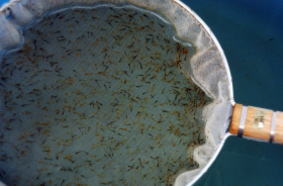 |
|
 |
|
|
40days after hatcing, around29cm |
|
Fry before selection. |
|
|
 |
|
 |
|
|
60days after hatcing, around 3cm |
|
80days after hatcing, around 9cm |
|
|
|
|
|
|
|
Autumn(Sept. - Nov.) |
|
|
In Autumn, we harvest koi from mud ponds. Koi at the harvest time show their beauty
the most. It is the time that all the hard work breeders had put is
evaluated.
Harvest is the time that the breeders are most nervous, for the expectation
for their koi, for hope that all koi will be harvested sefely, in good conditions.
When all koi are harvested safely, and in beautiful conditions, we feel
much relieved.
And the big smiles on the faces of our customers give us pleasures that
would pay for all the hard work during the raising season.
In autumn, there are many koi shows everywhere. These koi shows are where
koi breeders are put on the spotlights. This is the busiest season for koi-homeland,
with many people from everywhere. |
|
|
|
|
|
|
|
|
|
|
 |
|
 |
|
|
In Yamakoshi, there's so much beauty of nature. |
|
This seems like a big pond, but sometimes we can only put few big koi in
a pond like this. |
|
|
 |
|
 |
|
|
↑↑See how big Tosai grew in a few months. ↑↑ |
|
|
 |
|
 |
|
|
Much proud and satisfied with the harvest results. |
|
It gives us joy to look at fine koi from mud ponds, however many times
we see them. |
|
|
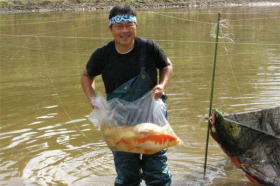 |
|
 |
|
|
It's fun and privilage to harvest koi from mud ponds. |
|
|
 |
|
 |
|
|
Very careful not to hurt koi throughout harvest time. |
|
Carefully cheching the conditions of fish before we take them into greenhouse
ponds. |
|
|
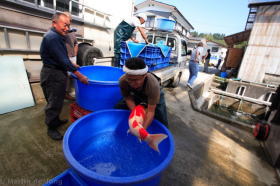 |
|
 |
|
|
It takes the best care and attention - the bigger fish are, the more
careful we need to be. It takes many years
of experience to be able to hold fish more
than 80cm long. |
|
Guys in full smiles after they had done a good job raising good fish. |
|
|
 |
|
 |
|
|
Harvest season is the busiest time of the year for koi breeders. We sometimes
come and go help each others for mud pond pull. |
|
Very carefully carrying koi so as not to put any extra stress on the fish. |
|
|
 |
|
 |
|
|
Koi came back in a very excellent condition. |
|
We keep our fish under close observation after the harvest, in greenhouse
ponds. |
|
|
 |
|
 |
|
|
When introducing koi right from the harvest into greenhouse
ponds, we let fish gradually get acclimated with the pond water. |
|
Observing closely at the koi we brought in
from mud ponds, with special attention. |
|
|
Sometimes we invite koi enthusiasts to join in our mud pond pull. |
|
|
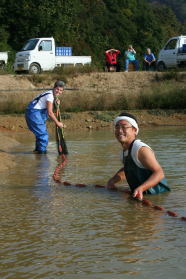 |
|
 |
|
 |
|
|
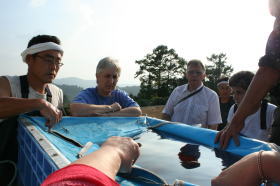 |
|
 |
|
|
Koi breeders love koi, too. Holding back the feelings to want to watch
koi longe timer, we take them back to greenhouses. The feeling of tension
is still there until we let them sefely back into greenhouse ponds. |
|
Many koi enthusiasts visit us from around the world. We hope every one
finds his/her own special koi. |
|
|
 |
|
 |
|
|
We have many groups of customers from many countries overseas in autumn
time. |
|
Selecting Nishikigoi is a very important thing for koi enthusiasts. We
try to be helpful when our customers select koi. |
|
|
 |
|
 |
|
|
It is a pleasure for us to receive prizes at koi shows. It makes us feel want to try harder to raise fine koi. There is no end to raising fine Nishikigoi. |
|
|
|
|
|
|
|
|
|
|
|
|
Winter(Dec. - Feb.) |
|
|
Winter time is time for koi to rest in greenhouse ponds.
It is important to give some time to rest in order for koi to go back to mud ponds
in healthy conditions in spring time.
But for Tosai fish, we grow them during winter so we can select fish that
are worth going back into mud ponds in spring. |
|
|
|
|
|
|
|
|
|
|
 |
|
 |
|
|
Mountains are all covered with snow, so are all the mud ponds. |
|
All koi harvested from mud ponds stay here in the greenhouse for the winter
time.
|
|
|
 |
|
 |
|
|
When it snows, it's all white around. But inside the greenhouse
・・・ ⇒⇒⇒⇒⇒ |
|
It's warm and nice for koi inside the greenhouse. Our koi swim in heated
ponds. We take care of our koi inside the greenhouse for the long winter.
↑Observing for health check. |
|
|
|
|
|
|
|
|